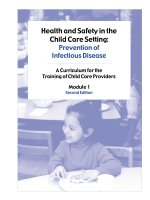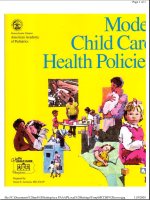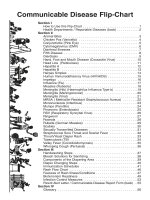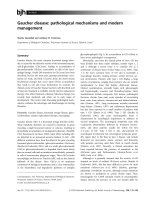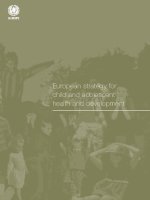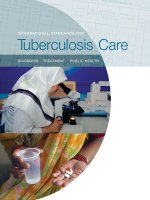COMMUNICABLE DISEASE CURRICULUM FOR CHILD CARE PROVIDERS ppt
Bạn đang xem bản rút gọn của tài liệu. Xem và tải ngay bản đầy đủ của tài liệu tại đây (1.99 MB, 54 trang )
Communicable Disease Curriculum
for Child Care Providers
2009
Department of Health
Department of Job and Family Services
Introduction
The Ohio Department of Job and Family Services
(ODJFS), the Ohio Department of Health (ODH) and the
Ohio Department of Education prepared this booklet
to provide information to child care providers about
communicable diseases, measures to take to control
the spread of diseases and related child health issues.
of prevention, recognition and management of
communicable disease. The curriculum is based upon
Caring for Our Children, National Health and Safety
Care and Infectious Disease Control Manual, and is produced
by ODH.
licensing rules, instructors may call the
ODJFS Helpdesk at 866-886-3537 (option 4)
or
the Web site for service providers
For further information on the content included in this course,
instructors may call ODH at 614-644-8389.
Table of Contents
Unit 1 - How Diseases are Spread
The Chain of Infection
Unit 2 - Prevention and Control of Disease
Child Emergency Information
Immunization and Health History for Child Care Staff
Tuberculosis Screening
Recommended Immunizations for Child Care Staff
CDC Immunization Chart
Ohio’s Health Insurance Program for Low Income Children/Families
Health Risks for Pregnant Child Care Staff
Environmental Control Measures (Hand Washing)
How To Wash Hands
Hand Washing Chart
Diapering
Procedure for Diapering
Cleaning and Sanitation Materials
Washing and Sanitizing Toys
Washing and Sanitizing Diaper Changing Areas
Washing and Sanitizing Clothing, Linen and Furnishings
Food Sanitation
Preparing and Handling Infant Formula and Foods
Infant Formula
Unit 3 - Care of the Well and Ill Child
Group Separation of Children
Exclusion for Illness in a Child
Signs of Illness in Children
Taking a Temperature
Readmission Criteria for Staff and Children
Children with Special Needs
Medication Administration
Unit 4 - Policy and Procedures
Local Health Departments
Communicable Diseases that Need to be Reported
Emergency Preparedness in Child Care
First Aid Kit
Ohio Child Care Licensing Rules for Health and Safety
Federal OSHA Rule
Unit 5- Fact Sheets- The fact sheets are now found on the ODJFS Web site
References
Appendix
Group Separation Chart
Infections — How Diseases are Spread
A communicable disease is a disease that can be spread from one person to another. Germs
cause communicable diseases. Most germs are very small and can be seen only with a
bacteria, virus, fungus or parasite.
Infants and toddlers are highly susceptible to contagious diseases. They have not yet been
exposed to many of the most common germs. Therefore, they have not yet built up resistance or
immunity to them. Also, young children have many behaviors that promote the spread of germs.
and leave the body and can then infect the child or be passed on to other children.
In order for communicable diseases to be transmitted from one person to another, certain
conditions are necessary for the germs to be spread from person to person. The conditions
involved in the spread of communicable disease are called the chain of infection below and
include the following:
be from an animal, in the air or on a surface.
A place to exit must be present for the germ to leave the source (reservoir). Examples of exit
pus, feces, vomitus, urine or blood.
A route of transmission is needed for the germ to enter the mouth, nose, blood or skin of
another person.
Germs must enter the body of another person (entry).
Host refers to the person who receives the germ. Any person may become a host. Some
enters their body.
The Chain of Infection
As the table on the following page shows, diseases are spread in the following ways:
Direct contact
Mouth and nose (respiratory): sneezing, coughing and runny nose by someone who has germs
allows the germs to spread to other people.
Fecal-oral (intestinal tract) infections, including some types of diarrhea, usually are spread
through exposure to germs in bowel movements (feces). This means germs leave the body of
the infected person in feces and enter the body of another person through the mouth. In most
if food or water is contaminated with invisible amounts of human or animal feces and then is
often the sources of infection with E. coli O157:H7 and Salmonella.
Blood infections
stream of another person. The germ enters the body through cuts or openings in the skin:
the mucous membrane that lines body cavities such as the nose and eye; or directly into the
bloodstream, as with a needle.
1.
2.
3.
4.
5.
6.
Transmission of Disease
How Some Infectious Diseases are Spread
Direct Contact
(with infected
person’s skin or
Mouth and Nose
Transmission (from
the lungs, throat or
nose of one person
to another person
through the air)
Transmission
(touching feces or
objects contaminated
with feces and then
the mouth)
Sexual
Transmission
Transmission
Chickenpox*
Cold Sores
Conjuncitivitis
Head Lice
Impetigo
Ringworm
Scabies
Measles*
MRSA
Mumps*
Pertussis*
Pneumonia*
Rubella*
Chickenpox*
Common Cold
Diptheria*
Fifth Disease
Disease
Impetigo
Pinworms
Polio*
Salmonella**
Shigella
Campylobacter**
E.Coli O 157:H7**
Enterovirus
Giardia
Disease
Hepatitis A
Infectious Diarrhea
Chlamydia
Hepatitis C
HIV Infection
Cytomegalovirus
Hepatitis C
HIV Infection
*Vaccines available for preventing these diseases.
**Often transmitted from infected animals through foods or direct contact.
***Head lice are not infectious but rather communicable.
Employee Safety-Use of
Standard Precautions in
Child Care
“Standard precautions” is the term used to describe
steps for child care staff to use to protect themselves
from potentially infectious diseases. The concept of
may hold contagious germs. In the 1980s the term
“universal precautions” described guidelines developed
by the Centers for Disease Control and Prevention (CDC) to
reduce the spread of infection to health care providers and
patients in health care settings. Standard precautions expanded
hold contagious germs. They are still primarily designed to prevent
excellent measures to prevent the spread of infectious disease in group care settings such as
child care facilities. Child care facilities must follow standard precautions.
NOTE: In ODJFS Ohio Administrative Code (OAC) rules “basic precautions.” means the same as
“standard precautions in child care.” Both terms refer to the same precautions in this manual.
Why are standard precautions needed?
Standard precautions are designed to reduce the risk of spreading infectious disease from both
recognized and unrecognized sources of infections. Germs that are spread through blood and
you must behave as if every individual might be infected with any germ in all situations that
What do standard precautions consist of?
Standard precautions include the following:
Hand washing
After diapering or toileting children.
After taking off your disposable gloves.
Remember, wearing gloves does not mean you don’t have to wash your hands.
Latex (or vinyl) gloves should be worn
contain blood you can see).
When staff members have cuts, scratches or rashes which cause breaks in the skin of their hands.
described in the Environmental Control section, which explains routine sanitizing and the
bags that are securely tied. Send these items home with the child. Items used for procedures
a “sharps” disposable container. This is a container made out of durable, rigid material which
safely stores the lancets or needles until the parent can take them home for disposal. Sharps
containers must be stored out of the reach of child.
Standard precautions in child care settings vs. hospitals and clinics
Child care facilities follow the same standard precautions as clinic and hospital settings with the
following exceptions:
may be involved.
Appropriate barriers include materials such as disposable diaper table paper, disposable
towels and surfaces that can be sanitized in group care settings.
What else am I required to do?
with staff (even family child care homes with assistants or volunteers) to have an Exposure Con
Exposure determination. This is a list of the job title or duties that might put an individual in
•
•
•
•
•
•
•
•
•
•
•
1.
Methods of compliance. These are the ways you will assure your plan will work and which
include written standard precautions and cleaning plans, training of staff in their use and the
availability of gloves.
Hepatitis B vaccination.
This must be offered by the employer at no cost to staff. The vaccine series can begin either:
Within 10 days of employment.
Within 24 hours after a potential blood exposure (accidental contact with blood while
29 CFR 1910.1030 and scroll down to 1910.1030(f)(1)(i).
Note:
happens that puts an employee in contact with blood on their broken skin (cuts, scratches,
open rashes or chapped skin) or on their mucous membranes (in the eye, mouth or nose).
Training on OSHA regulations. This should be provided to all staff at the time that they start
work and include:
An explanation of standard precautions and the exposure control plan for your program.
For more information contact:
(513) 841-4132
(216) 522-3818
(614) 469-5582
(419) 259-7542
Child Care Health Consultants:
Ohio Department of Health
Bureau of Early Intervention Services
(614) 644-8389
Adapted from:
California Childcare Health Program
PA Chapter
2.
•
•
3.
4.
•
•
Prevention and Control of Diseases
Control and prevention of communicable diseases are important for the following reasons:
communicable diseases can lead to serious health problems such as pneumonia, meningitis or
kidney disease; are easily spread to other people; and cause absenteeism. Immunization is one of
the most effective means to prevent the spread of diseases such as polio, measles and mumps.
In addition to immunization, hand washing is also one of the most effective means to prevent the
spread of disease on a daily basis.
physical exam and written proof of their immunizations. Each child in your care should have a
a medical condition or religious objection, this should be noted on the immunization record and
Several diseases that can cause serious problems for children and adults can be prevented by
but cases still occur. Staff and children in a child care setting are at increased risk for many of these
diseases because of the many hours they spend in close contact with other children.
The Ohio Department of Health (ODH) recommends children who are not up to date on their
immunizations be excluded from child care until they have begun the series of shots needed.
department for updates at least annually or go to: />immunize/cliloc.aspx.
Child Emergency Information
In addition to the immunization status, health and medical emergency information should be
child begins attending the facility. Information that must be known is:
Where parents can be reached, full names, work and home phone numbers, and addresses.
child care hours.
At least two local people to contact if parents can’t be reached and their phone numbers.
At least one person listed must be able to take responsibility for the child. These are people
designated by parents who will be able to pick up and care for the child when the parent
separate list.
The name of the child’s regular health care providers (physician, nurse practitioner), their
addresses and phone numbers.
Each child (except those children who are attending a grade of kindergarten or above) needs
updated every 13 months thereafter, until the child is attending kindergarten.
Any special health problems or medical conditions that a child may have and procedures to
follow to deal with these conditions. Examples of conditions needing procedures are allergies,
•
•
•
•
•
asthma, diabetes, epilepsy and sickle cell anemia. These conditions can cause sudden attacks
a crisis related to the condition; 2) how to prevent a crisis; 3) how to deal with a crisis; and 4)
whether you need training in a particular emergency procedure. A Medical/Physical Care Plan
Immunization and Health History for Child
Care Staff
Children, especially those in groups, are more likely to get certain communicable diseases than
who has fewer contacts with children. To protect yourself and children in your care, you need to
know what immunizations you received as a child and if you had certain childhood diseases. If
you are not sure, your health care provider can test your blood to determine if you are immune
to some of these diseases and can vaccinate you against those to which you are not immune.
Staff should be immunized against measles-mumps-rubella [MMR], tetanus-diphtheria [Td] or
tetanus-diphtheria-pertussis [Tdap], and varicella (if no history of disease). All childcare workers
(See: Standard Precautions). Individuals should also consult with their primary health provider
immunizations of adults in other occupations and settings.
A) each employee must have a medical statement signed by their health care provider verifying they
Tuberculosis (TB) Screening
Persons who have the following symptoms at any time should not attend, work or volunteer at
persistent cough lasting longer than two or three weeks; coughing up blood; unexplained
weight loss; night sweats; fatigue; fever. Persons who have active or suspected active infectious
determined they may return to the center.
•
Recommended Immunizations
Immunization How often Why
All child care staff, especially those who
have chronic health conditions or are over
50 years of age should be immunized
yearly, starting in October, because a new
to protect against the viruses expected that
year.
Flu is a respiratory disease and causes fever, chills,
headache, muscle ache, sore throat, cough and cold
symptoms. Vomiting and diarrhea are usually not seen
elderly and those with chronic illnesses or weak
immune systems.
Measles
Mumps
Rubella
(MMR)
Child care staff should be immune to
measles, mumps and rubella. Stafff born
before 1957 can be considered immune
to measles and mumps. Others can be
considered immune if they have a history
of measles or mumps disease or have
received at least one dose of vaccine on or
of rubella disease is often unreliable, only
a blood test indicating immunity to rubella
or documented receipt of at least one dose
immunity.
Measles, mumps and rubella vaccines are usually
given together as MMR. Most experts recommend two
doses of MMR for persons wothout other evidence of
immunity. Measles: two to three people out of every
1,000 who contact measles die from complications
such as pnuemonia or encephalitis. Encephalitis
convulsions, deafness or mental retardation. Measles
during pregnancy increases the risk of premature labor,
spontaneous abortion and low birth wieght.
Mumps: Fifteen percent of cases are in adolescents and
or sexual organs and may cause permanent deafness or
sterility.
Rubella: Rubella may cause miscarriage, stillbirth and
multiple birth defects (congenital disorders, mental
Recommended Immunizations
Immunization How often Why
Tetanus
Diptheria (Td)
Child care staff should have a record of receiving a
series of three doses (usually DTP given in childhood)
and a booster dose (Td or Tdap) given within the past
10 years.
Tetanus (lockjaw) causes painful muscular
contractions. Forty to 50 percent of persons who
contract tetanus die. Diptheria affects throat and
nasal passges, interferes with breathing and
produces a toxin that damages the heart, kidneys
and nerves. Ten percent of cases are fatal.
Polio Child care staff, especially those working with
record of a primary series of three doses (usually
given in childhood) and a supplementary dose given
at least six months after the third dose in the primary
series.
Polio attacks the nervous system and can cause
paralysis in legs or other areas.
Hepatitis A Hepatitis A vaccine is not routinely recommended
for child care staff but may be indicated if the local
health department determines the risk of hepatitis
A in the community is high. Any person who travels
hepatitis A vaccine.
Hepatitis A is a liver infection that couses fever, a loss
of appetite, nausea, diarrhea and generally ill feeling
that may persist for weeks. During an outbreak in
a child care setting, hepatitis A spreads easily and
risk to child care staff in general does not seem to be
increased.
Chickenpox Child care staff who know they have had chickenpox
(varicella) can assume they are immune. All other
staff should consider getting immunized against
chickenpox. Persons who believe they have never
had chickenpox or are unsure can be immunized.
In some areas, blood tests may be available to
determine if a person is susceptible and in need of
immunizations.
Chickenpox can be a severe disease in adults.
Child care staff are at high risk of being exposed to
chickenpox in the child care setting.
Child care staff who may have contact with blood or
developmentally disabled or aggressive children
series of three doses of vaccine.
persons will develop chronic hepatitis, which can
destroy the liver and raise the risk of getting liver
communicable to others for the rest of their lives.
CDC Immunization Chart
chart is updated yearly at CDC, the following link will provide the child care provider with a
schedule.htm#printable
Health Insurance for Ohio’s Children and
Families
Please share information with child care personnel and families about these two valuable health
insurance programs called Healthy Start (for children) and (Healthy Families) for families. A
summary of the Healthy Start program is provided below which was printed from the ODJFS
Web site: . Check the Web site for information
about the Healthy Families program and instructions for applying for both programs.
Healthy Start and Healthy Families are Ohio Medicaid programs that provide eligible Ohio
children, pregnant women and families comprehensive health coverage. In 2008, Ohio Medicaid
expanded Healthy Start eligibility guidelines to cover more of Ohio’s uninsured. Ohioans who
as doctor visits, prescriptions, hospital care, immunizations, vision and dental care, substance
abuse services, mental health services and more.
Healthy Start
Healthy Start covers children (up to age 19) in families with income at or below 200 percent of
the federal poverty level (FPL).
The program also covers pregnant women (any age) in families with income at or below 200
percent of the FPL and certain children younger than age 21 aging out of the foster care system.
Pregnant women are eligible for Healthy Start coverage during the entire pregnancy and up to
for free health coverage for one full year from the date of birth.
Can children have other health insurance and still qualify for Healthy Start?
Children in families whose income is between 150 percent and 200 percent of the FPL must be
considered “uninsured” to be eligible for Healthy Start. Please note: Children in families with
Healthy Start Monthly Income Guidelines
for Children & Pregnant Women
Family Size 200%FPL
1 $1,805
2 $2,429
3 $3,052
4 $3,675
Based on 2009 federal poverty guidelines
and charge annually.
Healthy Start Monthly Income
(Insured vs. Uninsured)
Family Size 150% FPL 200% FPL
1 $1,354 $1,805
2 $1,822 $2,429
3 $2,289 $3,052
4 $2,757 $3,675
Based on 2009 federal poverty guidlines and
change annually.
See the chart on the right to see if a child
Healthy Start.
Health Risks for Pregnant Child Care Staff
Introduction: Several common childhood diseases may be harmful to either the unborn child
details follow:
Cytomegalovirus (CMV)
Prevalence:
been found to actively shed CMV virus in their saliva and urine.
Maternal effects: Women may either have no symptoms or a combination of the following:
fever, fatigue, muscle aches, chills and enlarged lymph nodes in the neck.
Fetal effects: Leading cause of hearing loss in children; other possible effects include blindness,
Prevention: There is not an available CMV vaccine. Passive prophylaxis has not been well
physicians. Prevention of congenital infection depends on good hygiene and hand washing
Treatment: None
NOTE: Prior infection does not provide permanent immunity; this is an infection that a woman
could have more than once.
Prevalence:
illness annually, leading to an average of 20,000 to 40,000 deaths per year.
Maternal effects:
women so infected.
Fetal effects:
Prevention:
for Disease Control and Prevention recommend that all pregnant women be vaccinated during
Treatment: Supportive care and antiviral medication for acute and/or severe infection.
Mumps
Prevalence:
Maternal effects:
Fetal effects: Miscarriage risk may be increased but there is not increased risk for birth defects.
Prevention: A vaccine is available; since it contains attenuated live virus, it should not be given
to pregnant women and pregnancy should be avoided for one month after receiving the vaccine.
Treatment: Treatment for symptoms
Parvovirus (Fifth disease or erythema infectiosum)
Prevalence:
avoid infected children, because infectivity is greatest before any sign of clinical illness.
Maternal effects:
adults have no symptoms.
Fetal effects: Miscarriage, nonimmune hydrops, or fetal death.
Prevention: There is no vaccine for this virus nor is there any evidence that antiviral treatment
Treatment: Treatment for symptoms
Rubella (German or 3-day measles)
Prevalence:
virus and may become infected after exposure.
Maternal effects: Mild illness involving fever and a rash. May also have joint pain and enlarged
lymph nodes.
Fetal effects: Miscarriage and congenital rubella syndrome. The syndrome includes growth
of the heart, eye problems and mental retardation.
Prevention: A vaccine is available; since it contains attenuated live virus, it should not be given
to pregnant women and pregnancy should be avoided for one month after receiving the vaccine.
Treatment: Treatment for symptoms
Rubeola (Measles)
Prevalence: Most adults are immune due to childhood vaccinations
Maternal effects: Fever, fatigue, muscle aches, headache, and rash. Rare complications include
Fetal effects: Miscarriage and premature delivery
Prevention: A vaccine has been available since the 1960’s. Since it contains attenuated live
virus, it should not be given to pregnant women and pregnancy should be avoided for one
receive immune serum globulin within six (6) days of exposure.
Treatment: Treatment for symptoms
Varicella (Chickenpox or shingles)
Prevalence:
having chickenpox before.
Maternal effects: Adults have a higher mortality rate than children. In pregnancy, maternal
Fetal effects: Miscarriage, fetal death, or birth defects are possible. There is a low risk of birth
maternal infections beyond 20 weeks’.
Prevention:
pregnancy and pregnancy should be avoided for 3 months after each shot.
If exposed to the infection, all pregnant women who are either known not to be immune or have
no clinical history and do not know their immune status, should contact their obstetrician for
administration of two therapies:
Varicella immune globulin (VZIG) should be given as a shot within 96 hours of exposure; this
infection rates.
Given the time constraints involved in giving these medications, women with no history
of having had chickenpox should consider having a blood test to check for immunity at the
beginning of pregnancy.
Treatment: Supportive care including calamine lotion and medications to reduce fever and
itching. Oral acyclovir (prescription medication) is safe in pregnancy and may decrease the
duration of illness if given within 24 hours of rash development.
•
•
Environmental Control Measures
In addition to the prevention of disease through immunizations, good child monitoring and
environmental practices will reduce the spread of illness in the child care center.
In this edition of Handbook for Common Childhood Illnesses, the term sanitize is used
throughout to describe the process of removing most germs from an object or a surface. The
in Caring for Our Children, National Health and Safety Performance Standards: Guidelines for
Hand washing: The single most effective practice that prevents the spread of germs in a child
care setting is good hand washing by child care staff, children and others. Some activities in
particular expose children and staff to germs or the opportunity to spread them. The spread of
germs can be stopped by washing your hands and teaching the children in your care good hand
washing practices.
Children should wash their hands:
Immediately after eating — Recommended
Staff should wash their hands:
Immediately before handling food, preparing bottles or feeding children — ODJFS Rule
•
•
•
•
•
•
•
•
•
•
•
•
After using the toilet, assisting a child in using the toilet or changing diapers — ODJFS Rule
When hands are visibly dirty or after cleaning up a child, the room, bathroom items or toys—
Recommended
After sneezing and coughing — Recommended
— Recommended
be considered a substitute for hand washing. When removing gloves be careful to avoid skin
contact.
Rubbing hands together under warm, running water and soap is the most important part of
not be used as a substitute for washing hands with soap and running water. Disposable
wipes should be used only to remove residue such as food off a baby’s face or feces from a
baby’s bottom during diaper changing. When out of the child care setting and running water is
unavailable such as during an outing, disposable wipes may be used as a temporary measure
until hands can be washed under warm, running water. Child care staff may use a disposable
wipe to clean hands while diapering a child who cannot be left alone on a changing table that
is not within reach of running water. However, hands should be washed when diapering is
completed and the child is removed from the changing table. Water basins should not be used
as an alternative to running water. If forced to use a water basin as a temporary measure, clean
and sanitize the basin between each use (refer to section on Cleaning and Sanitation Materials).
When necessary use disposable products. Avoid the use of a community basin or shared
washcloth. Outbreaks have been linked with sharing wash water and washbasins.
NOTE: Alcohol rubs must not be used on children because they contain an active ingredient.
Alcohol rubs must be kept out of the reach of children because they are poisonous if ingested.
Remember, child care providers are role models for good health practices. Children learn by
sanitizers but must be used according to Ohio Child Care Rules. These should not be used on
children.
How to Wash Hands
be used because their effectiveness has not been proven and may decrease the resistance
of organisms in a individual to antibiotics. Disposable hand wipes do not effectively clean
•
•
•
•
•
•
•
•
•
•
•
hands and do not take the place of hand washing.
Rub hands together vigorously until a soapy lather appears and continue for at least 15
of the hands.
Rinse hands under warm, running water. Leave the water running while drying hands.
Dry hands with a clean, disposable (or single use) towel, being careful to avoid touching the
faucet handles or towel holder with clean hands.
Turn the faucet off using the towel as a barrier between your hands and the faucet handle.
When assisting a child in hand washing, either hold the child (if an infant) or have the child
stand on a safety step at a height at which the child’s hands can hang freely under the
running water. Assist the child in performing all of the above steps and then wash your own
hands.
•
•
•
•
•
•
•
Hand Washing Chart
The following chart explains the hand washing procedure and may be used as a poster.
Diapering
Two different diaper changing methods may be used to minimize the risk of transmitting
infection from one child to another or to staff. One method involves the use of gloves and the
other does not. The method selected should be used consistently by the staff. Whichever method
is chosen, never wash or rinse diapers or clothes soiled with fecal material in the child care
surfaces, rinsing increases the risk that staff and children would be exposed to germs that cause
infection. All soiled clothing should be bagged and sent home with the child without rinsing.
procedure and why it is important.
Procedure for Diapering a Child
The following chart explains the procedure for diapering.
Using Toilet-training Equipment
ing, you should use potty chairs only in a bathroom area and out of reach of toilets or other potty
chairs. After each use of a potty chair, you should:
Immediately empty the contents into a toilet, being careful not to splash or touch the water in
the toilet.
Rinse the potty with water from a sink used only for custodial cleaning.
DO NOT rinse the potty in a sink used for washing hands or food preparation.
Dump the rinse water into a toilet.
Wash and sanitize the potty chair. (See Cleaning and Sanitation Materials).
Wash and sanitize the sink and all exposed surfaces.
Wash your hands and the child’s hands thoroughly.
Cleaning and Sanitation Materials
Keeping the child care environment clean and orderly is very important for health, safety and
important steps in reducing the number of germs and therefore the spread of disease is the
thorough cleaning of surfaces. Surfaces considered most likely to be contaminated are those
with which children have close contact. These include toys that children put in their mouths, food
preparation areas and surfaces likely to become very contaminated with germs such as diaper
changing areas.
cleaning with detergent and water is the most useful method for removing germs from surfaces
in the child care setting. Good mechanical cleaning (scrubbing with soap and water) physically
reduces the number of germs on the surface, just as hand washing reduces the number of
germs on the hands. Removing germs in the child care setting is especially important for soiled
surfaces that cannot be treated with chemical sanitizers such as some upholstery fabrics.
Some items and surfaces should receive an additional step, sanitation, to kill germs after
cleaning with detergent and rinsing with clear water. Items that can be washed in a dishwasher
or hot cycle of a washing machine do not have to be sanitized because these machines use
water that is hot enough for a long enough period of time to kill most germs. Sanitation is the
several minutes to give the chemical time to kill the remaining germs. Commercial products that
(solutions that kill germs) may be used for this purpose.
One of the most effective chemicals for sanitation in child care settings is a homemade
solution of household bleach and water.
inexpensive and easy to get. The solution of bleach and water is easy to mix, is nontoxic, is safe
if handled properly and kills most infectious agents except parasites.
Research by health care organizations and manufacturers recommend the following exposure
time and concentration:
•
•
•
•
•
•
•
food surfaces.)
Wipe dry after two minutes of contact time or allow to air dry.
Weaker bleach recipe for sanitizing food preparation surfaces, kitchen utensils and toys that
with detergents and rinsed.
1 tablespoon of bleach + 1 gallon (16 cups = 1 gallon) of cool water
Wipe after two minutes of contact time or allow to air dry.
Discard bleach solution at the end of the day. A solution of bleach and water loses its strength
Therefore, bleach solution must be mixed fresh each day to make sure it is effective. Any leftover
solution should be discarded at the end of the day. NEVER mix bleach with anything but fresh
tap water! Other chemicals may react with bleach and create and release a toxic chlorine gas.
Keep the labeled bleach solution you mix each day in a cool place out of direct sunlight and out
of the reach of children.
Industrial Products
There are a number of industrial products that are available. Industrial products that meet the
product must be appropriate for the surface or item you are sanitizing.
“germicidal action” or that “kill germs.” While they may have some effect on germs, they may
Questions about commercial products must be directed to the manufacturer of the product or
manufacturer’s instructions exactly.
Cleaning Tips When Using Bleach
Infant/diapering area: Wipe down painted cribs, changing tables, diaper pails, plastic mattress
covers, crib bumpers and high chairs with the bleach solution (1/4 cup bleach + 1 gallon of cool
water). Let stand for two minutes, rinse and dry.
Toys:
toys in the sanitizing solutions for 10–20 minutes. After they have soaked, remove them, rinse
with water and air dry. (A net bag works well for submerging the toys which can be used to hold
the toys while they air dry).
Refer to the section on Food Sanitation on how to clean food surface areas.
1.
•
•
2.
•
•


